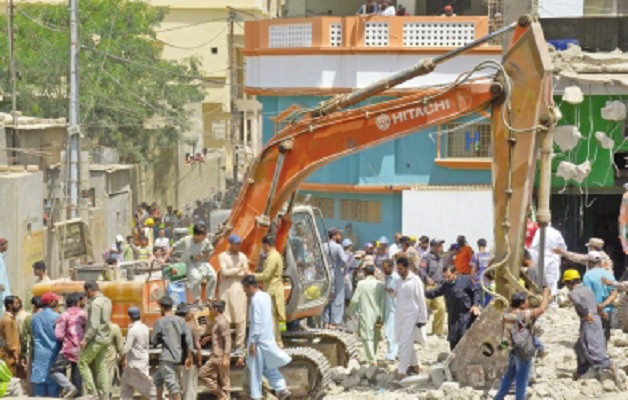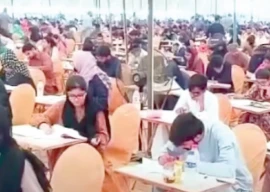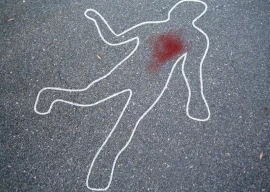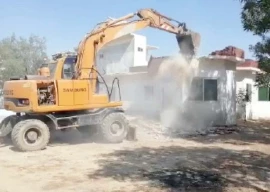
Ask any citizen of Hyderabad what single local activity drew their attention, and worry as well, in the outgoing year, and many would say the anti-encroachment operations. The city's most areas dealt with varying magnitudes of this drive, which was started on the order of Sindh High Court Hyderabad circuit bench, unlike any time in the past.
Even the public utility like Hyderabad Electric Supply Company was compelled to relocate its transmission infrastructure, installed without approval of the local authorities, from six-kilometer stretch of Wadhu Wah road. Nevertheless, the company's poles in many other areas still exist on the encroached land.
The campaign targeted both the hard and soft encroachments. The former refers to the concrete structures built on the public property or the government land. And, the latter comes in the form of placement of hotel chairs and tables, carts, cabins, generators, products being sold by shops and parking of cars and motorbikes by the showrooms on the roads and footpaths.
The land belonging to the irrigation and forest departments of the Sindh government was also vacated from the squatters. The former was able to retrieve 246 acres out 348 acres and the latter 778 acres out of 836 acres from the squatters.
The houses, shops and other structures which had occupied roads and footpaths were demolished mainly in Qasimabad and Latifabad talukas. The builders and developers were barred from constructing high-rise buildings in almost entire Latifabad taluka and the conversion of land from residential to commercial was also proscribed by the court.
The district administration had complained to the court that Sindh Building Control Authority (SBCA), Hyderabad Municipal Corporation (HMC) and Hyderabad Development Authority (HDA) are approving construction of buildings on the plots converted from residential to commercial. The exercise lead to unbridled expansion of the concrete jungle, putting immense pressure particularly on the water supply and drainage systems, besides causing traffic congestion.
Read More: Anti-encroachment efforts continue at Nullah Jab
In a rare order, the recommendations for removal of encroachments in Hyderabad, which were submitted by deputy commissioner Fuad Ghaffar Soomro, were turned into an order of the SHC in March this year.
In another watershed order, the SHC on recommendation of the DC deprived the SBCA from keeping a huge proportion of the betterment charges, a tax for development works levied on the commercial building projects. The authority used to keep 40% and share as much with the HMC.
However, Water and Sanitation Agency (WASA), which undertakes infrastructure development for the commercial buildings, was given only 20%. On the DC's proposal, the court ordered that 60% of the charges should be given to WASA, 30% to HMC and only 10% to SBCA. The Sindh government notified the new rates in compliance of the order.
A force of 73 personnel has recently been given under control of the DC for their deployment in the campaign. A notification in this regard was issued by the secretary board of revenue on November 23. The SHC ordered the DC to only employ the force in the removal but also for identification of encroachment.
Yet, despite many an accomplishments with no recent precedent, failures remain and so do the obstacles. The hard encroachment still exists in many areas. The soft encroachment continues to pose a challenge to the authorities. During a hearing of the anti encroachment case in the SHC, the DC said the staff of the HMC and Municipal Committee Qasimabad takes bribe from the encroachers who either set up or extend their businesses to the roads and footpaths.
At the last hearing of the case on December 23, the SHC ordered the district judiciary to assign a judicial magistrate the task to inspect removal of encroachments from the areas identified by the local authorities. A report in this regard will be submitted at the next hearing on January 21, 2022. The Cantonment Board of Hyderabad has also been put on notice to explain alleged non-compliance in the drive.
Contradictions also seem to exist in the approach of the district administration. On one hand the encroachment was removed from Wadhu road for the road widening project. But, on the other hand, Shaheed Zulfiqar Ali Bhutto road which intersects the same Wadhu Wah road, is seeing destruction of the green belt for the same purpose.
In Qasimabad, more than six kilometer long green belt, whose width varies between six to 15 feet, is being removed to provide land for the road expansion. The belt stretches from Sehrish Nagar to Alamdar Chowk and from Alamdar Chowk to the underpass bridge of Bhitai Nagar. It has emerged as the most expensive stretch of the commercial properties in the town.
In the first phase, the belt is being removed from around 2-km stretch starting from Alamdar Chowk to Ali Palace. Either sides of this dual-carriage road, which is separated by the green belt, has come under 15 to 20 feet encroachment on both sides. The authorities seem to have evaded anti encroachment operation on this part of the city, finding destruction of the belt as an easier solution.
Published in The Express Tribune, January 1st, 2022.


1730959638-0/trump-(19)1730959638-0-165x106.webp)


















COMMENTS
Comments are moderated and generally will be posted if they are on-topic and not abusive.
For more information, please see our Comments FAQ